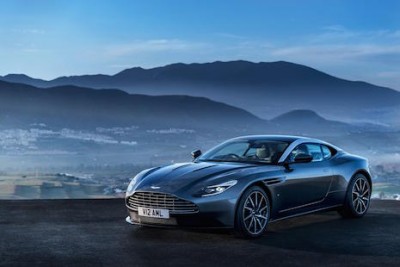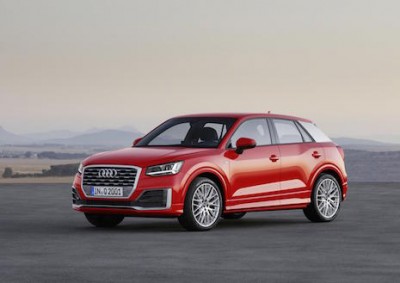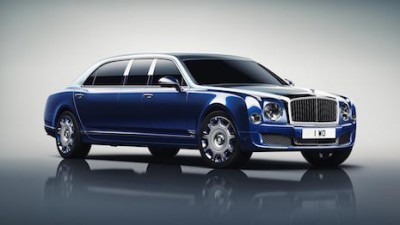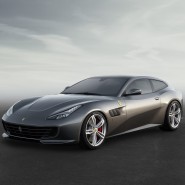Automakers are being pulled in opposite directions, with the convenience of an SUV now as alluring as the roar of a high-powered engine.
At the 86th International Geneva Motor Show, which ran March 3-13, luxury automakers revealed their latest sports cars as well as new SUV models in a bid for new consumers. The automotive world is rife with contradictions, and the need for speed and style faces off with the desire for sustainability and convenience.
"Bugatti's new Chiron, the replacement for the Veyron, is exceptionally special in design and performance," said Bob Prosser, CEO of Auto World Marketing. "The price and performance reflects this."
"Bugatti says they might make a sedan, but say they definitely won't do an SUV," he added.
Speed vs. size
The Chiron led the race among supercar makers. With 1500 BHP, the $2.66 million sports car requires only 2.5 seconds to reach 60 seconds and a top speed of 288 mph. Only 500 of the vehicles will be produced.
Aston Martin also revealed its latest supercar, the DB11 follow-up to the James Bond-only DB10, at the show. The DB11’s 600 BHP and 700Nm of torque make it the most powerful DB model yet developed, with a top speed of 200 mph and a 0-62 speed of 3.9 seconds.

Aston Martin DB11
Lamborghini also showed off its latest model, the Centenario, in Geneva. With a nearly $2 million price tag attached, the Centenario and its V12 engine has a top speed that approaches 220 mph and can move from a stop to 62 mph in a staggering 2.8 seconds.
McLaren’s 570GT and Ferrari’s GTC4Lusso also debuted at the show. In recent years, Geneva has emerged as a favorite among supercar producers because of the affluent clientele that live in the city and attend the event.
Nevertheless, an opposing trend was also on display among high-end European automakers. SUVs may have been dismissed as American symbols of excess at one time, but now European brands are producing their own models.
Maserati revealed its Levante (see story), and Audi showed off its Q2. They join a crowding luxury SUV and crossover space that already includes Bentley, Porsche, Land Rover and Tesla, among others, with the Aston Martin DBX and Lamborghini Urus on the way.

Audi Q2
To some extent, these cars are all in response to a young consumer's desire for more convenient vehicles. Audi’s Q2 will retail for $31,000, well below the $39,000 starting price for the Mercedes GLA.
A lower price will help Audi appeal to these young consumers with more limited buying power, possibly turning them into fans and positioning itself in the long term against Mercedes and BMW, whose X2 will mark the start of the brand’s intended SUV expansion.
Even Ferrari’s GTC4Lusso, a rare, but increasingly common, four-seater from the brand, is geared toward younger consumers and designed for all-purpose driving (see story).

Bentley Grand Limousine by Mulliner
Other highlights from the show included Bentley's "smart-glass" equipped Grand Limousine by Mulliner and Rolls-Royce's reveal 0f a new bespoke Phantom, limited to just 30. Porsche, meanwhile, joined the speedsters with its 500 hp 911 R, the lightest in the series.
Arguably the brand that best brought together these conflicting features was Tesla. The electric automaker brought along its Model X crossover SUV, which began deliveries last September. With a 0-60 time of just 3.2 seconds, it presents the best of both worlds and is environmentally friendly to boot.
"They will sell them as fast as they can make them," Mr. Prosser said.
Into the future
Aside from brands revealing their latest and greatest, the Geneva Auto Show also highlighted the latest developments of vendors.
Goodyear revealed concept tires designed with autonomous driving in mind. One of them, the Goodyear Eagle-360, is a spherical tire that will allow cars to easily move in all directions rather than merely backwards and forward.
Such a tool is far ahead of today’s technology, but autonomous driving ubiquity is also at least a decade away. More futuristic, however, is a magnetic levitation system that would suspend the vehicle above the pavement making for smoother rides over gravel and other rough terrain.
In the nearer future, Goodyear has planned the Intelligrip tire design, which manages its own weight and temperature to allow for maximum safety. Both tires will have censors that will relay road and climate conditions and communicate with other vehicles.
Thanks to German automakers Mercedes-Benz and Audi, the general public is starting to see autonomous vehicles become a reality after years of mostly behind-the-scenes progress.
Even at the beginning of the decade, autonomous vehicles seemed more like an idea out of science fiction than an imminent reality, but development by Google and other tech companies and automakers has gradually brought the possibility to light. While the race will continue for years, consumers are getting their first look at the not-so-distant future (see story).
Several companies, including Goodyear and those in the tech space, are finding ways to help the automotive sector reach its autonomous driving goal.
By some measures, mass market automakers are leading the race for autonomous vehicles, but technology companies could shake things up.
Toyota, Bosch, Hyundai, GM and Nissan have patented the largest number of driverless automobile inventions, but the increased presence at Las Vegas’ Consumer Electronics Show Jan. 6-9 has given way to speculation that automakers will form partnerships with tech companies to speed development. Vehicles that drive themselves are still years away from the market, meaning that partnerships with tech companies could cause new leaders to emerge (see story).
{"ct":"x7VuhETBFC0PNvKufjWfrzS0zqHomgOzajKlBGBEC6RUSQCfjM6Mb1ptsyav+jRA7xni\/eoPrXVHl31FfhJjVvjijleHgNSbw\/4judH2MDUReK6YrWc87u+anGNNind3q+6RhmuSajRpv0U7SolVKuP6Uhm+OE5DtNJ+tI3h7RGResKX6Abk11lMuXXlPoIJ+H7tGfXiF1zCEibMePk0Yw1Zb6PajXsUYdBRDFMSfJdpLIWl95f\/h0Vm\/8xpnstRRRo8XU2iIlKE8Tf5Xhr2eUeJWygzntnRy8hLz1+f6+W53AoBkOb5gnMWQbg+5TVc1AKi+jvSk0tV\/ylgwj03iZFITZhjUmLTR3qpDsoIKC\/VkA5HUoEKq7wg\/dDYYe9ak979tTJcPswxTkSt6rEmpWzO15BBqC7MfxJmLFtsj6xbpl6wyX6yq0IA8aWudj8u4DZXpgnYz2UwQ3WfcfmkhA8xmem5knkwM16nIWV++Qr9fhirHsETYZ6w1uoRPOg9YjdWsZPJc7N9w\/1dc3haOBx9rae2FHScn6FtxYFoyB3DDLZPPUt8piuzWTBkpVoCXffEMgvnGqfqKVk3aCLOjLRg+u\/ynLkVY1ulj3pos+z9q0Rv\/STkc4eO9NlvtxEJDI91wp6p\/paEjYU\/9ZRtBoZkbxpdwmJ0IBX4KTHN3L\/StMIQ05KArx8d0fDBxzLO\/4\/rAUAUv8pS5hVZloxN26oBEJ0X+bUy+FKXQDHW\/hs+hRJLg8xTbaBQCV9uYtBYmIGYp\/1KAkzx1eDQ5JeIHLxfW+EH7OwOloTuV0Q1hF1D4C\/TTjVznCCofnKg2UN9Hn0MU8YCx09goIfoyS46V6A3CypcAVkr3X5YiaMHCEg5CKwZcXNV\/suia3+T4XFVlVa32NcoWNoFwD2T\/6ij2Dfd7v4XcrjG161YSbaw\/f6tLu+1RG6ibh9LaK4UahELMxOd+xkEuYGuHGCHscwMJ8dlkBXfC5IWN1BuvIHeaor+7NVw89i5we1fvVmjvdRmNFJdrfINHbVTQ+gA2KiHZUCuFoMn2wDMiTH9JBv3owrVU7b7tjoI\/GB8i8QI4Yxqlqf1\/v\/eIMOBA3LD2F4diTCSnFiNMuvu+JYneQFxpfg38OFxZM7c2KVutqQz5ebrP5nrw1ih5dxiAbssFapQmhVKKywmJtqAR1MLZj91C+O5GjHAZ4ZC5cm1F+8sJQ5DE\/dLvyzg1AdW++2pxQSpK65TQNcayl3XEL7zYFyIhSaXW+tS9adtJ4WqH3qFcPMCZBK2Se0PzInxD0GBvHIxsqf4JCVTOck0079OPpxGY7efl+SNMd0KhcBh9nT+UdyuvZnDVdNUx\/I7VvNhDxeYEY+9LuCOg69Kf8RhDtchHVUl4RPwxjKIcd+hWDx29sEabym6VI3LIIeU7uF7Jqu\/6b1WJEcMbVC\/eBHrykDrVaZ1d+NVkG98vKhKuhrJJp7Ncd2k3TKAymvvQn147c1TBAdUvWFHgL9kjDya3AvT11FMCY1ooUUl6J\/RjnTSg\/csTyzIHnV1OiI6ripb\/Vh0yxVYdVpzhz0niGPjGrfxqRZ2FL4RCDxAjNqcIbsIqGi0x8sdACIGRw\/WjVWI\/z9nVsdSiZcy6vEq\/OjXYwQGuIZf7zr6wRmEDJwhzcohgOdVihAp59vSppf2liv+Awq8F09SbbaPmZXjVrk\/9PoAnhojmdU5J1Eztp1UuLM\/YOaVEiOhppbSoUFedMaw80fKz2VL57z06vknFWmdNbdsacs+8kKm1qu28hWWNxnOLTx+vTkltYEWhthr1V+AUomd2+I\/0gITH72w5S7vdOIgSosXBS6YhLk26JiXdwcVsTyVCx0ZuE3HipeFNQTtj9YaXYiLfCL8rVrmWJGtSXxhXFyAmceDKHUwknYbNxn\/NIVlxufYczKjcfRse3zhl7w5F3Wxc6PamLh1YQpoe\/YQZZ7hftAF8CoAIM4X90MolMdJy2nxdSq4rjOVabEAWgYDo6zASeKUG7QCEJdtoJ2F1C9PpX+5XVWLDehm4OC\/qA1AqxkVSACFuNV46L3nK5Aq\/1ohKrCIfjQ2pBVBMjLPrIcu5Kp8I7rz+iQmMyGQUCBArortsU+Ii3mFQ5WwTmcufgzR0we4380O0SiC4HwXyyWy4Y8ozXDvv0ssos+q\/YjdoB3ONCKCpIvgiAYG4K7rZs8KqGy3NNGcwd2SzcM3sSacPzNW5la56I7B+27lWv4yCbJFrrHxuHD3FCfZtU3uRERdaMz2Pw+gjJ64IAhZrtuE+VDqw5ClYibLEnwaLnvIPBJULKV4T5B4WaKzsZn03CNC67yQRhUD7HL0KFDu+HcwYhFrNTo4XKYsvd0qseccKhf8fCyeshyVkzRnA98t8s9cuvGu7u0ApHOOu+4pN8SbPwoZijQ8iYzCCS1LNp3DlkEYIzmbU\/LMvx1YoR4IJtVkZdrbMpB2Arep96gqQJdMSuMMaUmMTA9DadtrEQs1dbxJELLg53dsKtOeFOel5KNtYT3GQvo0T5SRb2Y7YmLvXrh3UWQFO9wJWtvOpsIyLiKDHHM4hDCQy1LDx7H4ttEJtHmOcX3rE\/C5nhDpdeHI6qMbhL2eb8usXOzyHn5MLKzEzSxisEOAJEzGTN84O9HL1CBjy\/k0QnZzxWa2UexP561V3iOcav6NL6O2md\/5Hle4h8t72znDLzTo1OpidvxKDd2uH+xDxQfMfnyClcd\/KyzxWOSPjDqB70rvDDG0ISbVVM+EQdjRCKbXF8A0mNU40vqmU6chBgt552b4NTZeRNf6CfYWbrs1bt8XMgbKAaOkBqO5KRsJ9EVEPMOXacg2S+W9NcXG56t\/L5G2vqHIczpCi0DBh1QP8zf2QR4r8jPj+L47pIPed7FZ3gTKw6w\/P5UQX96GSl4cONPhvb+v6GOwgUUq5ELccZN6WXJSbWSLo44Jon5o7PRqd0fJ9CMZEpTa5SYY\/SAOu7ARIBLeR2YX1suEkfUUCLF1TIjMNuoKeDX1HrutmqC4vEeh+BfO86ZwCsZa59wg7ULI4cF06TukP9pavodTvdJVzmkmtWcKcY2RsS5T4SNV5E\/gII9nG3J5m7beOcqxP+KkcQo3A20\/CdI5Gij9mDPelWeu7dHBxir7WJ5Cx798oYVOmfZuvpKkNb2kOAFONoHOU89Ksy\/Mz0saUZc1pVUtZtPOh13ic+LC0IsCmnXUrDgLIDHgLUlJ7MnFYk+5GOJfcpaB0XGWMqFDittZhUKKFvRJjO0kvKZyRRUXCgWGoudc2Sp66uuM5cWkZNIr\/jVAZ99MtwoCflfxFLHEpsOEpsWOoi7YvxMqTJSoTEJ4fsQ1Ss8eBgjiTC3IUhzEIxLgnKk3fs6oaOlHNT3HEC+rX3fR3h6Nj3vyFB3V4oOMzN0zcRWbmIWh+StaXWLTWZ+zXVLeNuAx9DZXho8SRTgvF\/svh9ESlYBqksQTI5cY4RZ6aYDukhnIcfS4Ohu\/rNITJsjpCbfpWChWviINkoCeYT+lntcjy4hagpofgn1\/svitTc7mqOARK6d74OzDkBygvqiVmfNT\/Bjvr3G8W7EdWbhi4ZsqhfbKrEdDpC2xQyAfzhUdsQzBYNm8OH4k1zUmunKFGZhtz19NNfQyCbCeGg51dp8q\/81Ro1TlH6y85K3nMSQg1\/R6P5kwGPNpEna7US19H1cig+652xr86hOEol9+FRwj\/PfvtbrJAGJr5nRO17ESCrdz7qM79Fhu6Fl3uMiLC04840ntloCxovuApUzBTaAI91GiDRaXM1h8t7xD637fuma1XBhHHplslO9Fe+R9ssX9EwH+XRE\/qRLl6qV6KiHBotda4x3USqnbRmx5iyw2EkypavQGho4FrUeSsrd5yWN31fXh6t0ZzlMfUVLA7AhfXv1THmsSYpkMovlifGoXv0D21K3IyZ2FYQY46eNMb92HHuvNehNmlXtREhUWacMmgQTNf5Z9JLDqNjJIrHPCJp5tftTIA0WZD59C9S8DqKEeyr4G9iY64AOmsZHwwkcxqgG8W1x+swgHzgrgjjh0p5K7CD\/CFIwjgO2uvlkfuo5+ZNxNh2oQJ1I5sCguY\/YX+XdL1drWWByX4f0yUx0427u42ozE6CQnmw60gnr4DC4lkQ8jpo9uMXftHiKLTjg\/QJOUKOJlPgXPx3omUrwzRK\/iJ+XlzolgKL3W5PFxRy3aFKBsU5iRsYeb0yPQPgJp3LaIcfVbdrWykzQ9hDffILs1mMNiOX0U4EjkT4YEH5alay10EDLPQIySGzhcmxc2bOQ3b4OPSgkKtq83XziBxY7tGYZwsv\/dj51+y9y0evVPavf66W6IoKQL\/s7qso5AjVYHVC6bPe404t7ZgbJyvILBhNRtgkJIekVnUEisSqwc+lJ+ghX2rdREto\/3swR3KTf3rZ2cDSCGyVQUyyBAPWg4hbJjOF8i8z5FE8hBDGzgXJ2UHH9nW3M\/sQkvZQgbD+weYDspo\/irInNKav2S76YVtyPe3M9OjGIf3jKwddWkmkEcA9JfOHaJVg9C7HnyJjWOZn0ilpvhodlHzso5Zrxi0inRB3YgRXBJmMuCocpgnxZ+U8fKEuWXOw9ogAyda0Bk7yi9aC+g8WWXNaJavqQdQckIgjjGn3Xw6rgsCYGNAzNM0lw7EJJZDpdEG9ee00RNd+sr5oBYhFbPgHOcgNtqcjdwAK9\/6KD19T2UalL+Dzd+epW3J+3E1zIxBr2TBBJr9adXOZOT2HRFI5KbOoyK9nVVLIz8zrXduzcg23S1rdMqP\/kTL5u0VgB36dSS0u6QfY4ChjxsZ8B0qYuSo3jhiQ3W4KgMOU9Yn7eyG64sm9aAns6YGoseLXIFgVgS+NLjpdV4qNbu0VG7gWZU7vULEpNLXpBCHm5uNRA7No56VpJCNYFxk\/1KmoWOo7H4l3kvhuSh5DRfkEeVFqLCnSch6Ee2HH9FlRATrWm3LVcU1KQmJUK8ZGgAoFBTKCukhwIXzRtVu6HGzsjM5gwaoe2xsmxeFoZUFwyJMkmmUeTkwx8HJkXU8cy4x7o66lsAO2SKZkC7Kn0t3Te1SyxXXt9re+yKCKr1jCfFKBTBBeT+n0maHAt6sycNJU1cHOmenOANXywpKcx3lpxKbXspksOUYlKPTHWmxPP3c664PHL+bcelICHKhnFFHS4u4dgtB\/J2EAW364kocltwH4jnxC94zQWEAe2MnkEY041W8O1di4PR+JcKDepDgpHlYuEzwaOO7H\/EjsQ9Qo2mbvdd7zVmVI3XLLJhXYd7h+JvAck0OoQr+cLx1wVVfOnk3lyxDOAE4LYKMY+bUWh8niZQAeErnJnTblBk4gYbSRS1rZurFkpCE842iIllIgTAJrFWsdu5dim+meBalYfLBP5e6aej1yIcyZ63yylD4klbFUW2xRqsfN4GeGEnTwc7cDoc13+Bo6qRWxsFfzIsyXSp9PGA5F\/D8b9olDqc\/O2Us8UZUKuu11nFSWik1v\/RYe+2KB9y3oUPb6W2iAMQoxjjk\/Tf0rVQygaQ+gJAR6LqdEa\/vMEGy4in+5onY3b3Kn65AmiGWQK68yOnWPEt88N2g8NTM+\/tlV\/qg291RfzNJ\/2sojdma4DJ3+HzBPbPDYIPrc7gkAPuBSAjqslDLo1RwO0puuZUQOrB8cpyOskAENenvBifiCms8tY2eMo0T2Sg0gkafQ330FpU+eQtR9PNxCNaUncxZ\/iL4M3swxKLD9Tk3uh8Ud84Fujimmpjq9fk41fyyEHHbbwND1bpBbj9w0YNbqzRZkkz1paxEvM3xvsXNH4SiwFATt9vdJ8bPqGdw1VpYz53NRDqFrH7EpYAewVXwqTIFPkpE5w5IdpQNfKQVuRwz06HSdzPNsuLAGNLbAUgo\/iBPn5lRnck1V17W8ZJ+RlENXIFpDji5Y65oaZzbo0\/Yg4DbcEZXHcjUinYYwYpja6N1gq9szg\/slS6KE4VUK1wBBZ+zw5eV9d0HX3Ldvt2Pxhcc2EryIi16QrTHL0v\/P4cw1WWywVTO8NWioC8elRpQAY4D\/tOLMp\/4YGDq9LD3ER5q5RFmtOQFo\/eWyVb7vAVBiCLGjj6N9caZDGwD51aWZb2pwXG4u+aDwNqjgAN4LJrhX6mC1BPhHKpiIUC6XvudHqflQHfhTSOoVULmzmoXdt6mBnMCBnXwzwryJCoIWOS4cmXmT7Ebao5gEH\/yzzU7VaTwVELfB9HtnGTDQNYT6W7jztGsRo2+oZFGtpUzilUTVhQgvyb\/3X5igz2mTTVo9SVoxPsUFn9r+QgWeSCuldtkyoz5aodiPTUC7q1IEotxWSOIF3L2yz3\/9J4Jj2OBotURJd++vqHqMfPsmRW+Vwf0+ZQF4qw\/OZOIjjoTsRQyVUowduP8CVq+VpSWef82q0aEzbG2NE1eSW8V4\/9Nuf+FrmgiQmfjFQO9mmjBdh5ClGHOAhKDFSVdTk9rk77LScOUNdE9bWeJfgQnzqGGaPGcmvpNrO8vSnoYWuvG92tseEjSnudXL4QKn+w8Khy12qQNRxE2pj6fksPpM479Hn0vKOx4aCjv\/qPZhA5NXHY24MB2BIkIM2fVMWGgWT3NSi\/B4iUW1dr\/SWuCVdIYRuTFvFWSn4ZRxp9bCvxojpGgtY9qc\/1v+2sz80fTjuPosWHsr6S2hLjeMvhcYfRFb5BJc4cXUCXS2m5NThGwt860GML07ZME+pnX0ZLOcdvYUB8YlsoELoFOB5oS7J8xSKbRd0bQjJo4uIvtCeLLVnYh7mrY9vcOsb1ujTtbibrNMWmbTlM1TI8WBxSzJqhzzNjivgLJu\/BE+mTZ6vlxPlBy2++PuOg5cWMKQBD5LnuPV7uo\/hrnItXusELGdhjsKJmJjOCNO5vMkzgvlL5fn7qYmmuxymZs0G6TfGIhZSvy7IzjVgELHVih2Nour0IpQiUzNDxiBdfDsTl5YzEB8Fik360QE8FLQ3FB37dakWudzQKLoBDFxj6IfBosLIaKCmavFsN6quD\/dRzKm1twN73Vm\/KMYQb744RNJoLTttW6gqOf7d7hiK5gBkfcOEwMOyRqHBL+9Hvr\/6eN8Ch0vKuMMTmYJv3JJXiTMc7RFuX8STcsy52E0uLGNODrzZRXdeIsIbrU+g6qwZZDSEXoENuspNvnENEWcW13E3mGU0I2KvZQ83AbaFh6x9FCi8TvJYtTl2x8nxdW5i8UaIfhj\/j6Rja83L4JoU6Ye7lOBR\/54vZkWotzj2dOEhuQdWfubKtAXWPNW84wQDkv2w\/aMoQZvXS1LL37FCILk9PT9c\/nuVYcuiiPuK6RraKa5RDYZAt\/0f+xLi5nW03XlYVGVoDmkDCL\/ad\/lrweoGNL\/CRdzv3mPgbuk1m44tQ2R1pdtZHovjj+2XWmVfxR4oz44PJCN8tQusA7VsmCYn7+BLAnGapnTfsTJiZ5+pnEOAV9jNPZmpH6DixSyhO0liAt57\/N69kLZpE38+so0dM432ESUiuKzG\/efdHPw6ZQSz4ods9v6ovs9Xziz4MOSJVR1dEiBixA57AC\/IYuoaGPrJUfIStOXkcJWvUsfhJwPKXfRhZZxZz9WTd95eDfmbS+U1vvzUgKRkz86cEP8Ld2Ar0d8dLXwPuRQX+cfiyfTDDV7aPWMsaELKy9ZaNptepksP\/86\/jnEHLkSm2VXJ\/ICmRcgpXjPimTVrc9cRHGLyAsHuOIguqUMpImg6a23v4zBlBMQcIl+oMp3MTG\/qlNX53n8w+zsFefaUE+lC0EtyQ8YTuzJMwYpmaVmD\/8rdcaOHO+YYTHGJVrvK7nHvsvEa7Ux+KTCCoxI6V\/XdlC6fVWI0hwS7x0foVAdQ2Ke+sbLl\/YYP\/e3JhiBp1X5orPaL4kf0\/vOwbvOqUWvdt5UqHmdsZySlUDRdKgGeLPkcYuWB0t6UARLfh\/t+gCp7AT\/ITqvPH2vaDsulmVHH5VakJUDgGRyVbbK2ZnUR8bGm4j\/6VnRgA3n9jl8bqZx8q4U4ov44C1+HVJ3pWmq2a2J0xU++SEploNBX8pbO1ingzMVx5qcDS61+qcl1d0N4o4fOXhNiENA\/lTN5XmWKgZYxS+\/L+vQ9X4I6iklM3CjyzN63u9RSfR7L8C21jolKhp8wMNL\/ffqT6aAUsFEHIz59ILMaZxZW6V6zPBInp8DfurmIZzRyYJFzB2CMWrEmvCM\/pwy5QT38TaI7Q51+Jb5nNRctLwD7APCNQE818I5RQ6NNl8PL5lb+vhUb+svI0pcjbqB3BuHUoRTZgMUIDWj5TN662+oxQqyJaR3TM3MRUX8NgIVMI2eb6hFeuSNSmc8OMboEV\/3tsIWsVPTe3oncxNxHMhvenXpVpwL0K3rQsbas6TKh9ymj3AgyY+VxiZUKjekRXOKFu4hQHX6TmMnWkujXQSmNeqzj\/J2XL15WJxtv2WQK\/yMDFLyUDmWUSCncOblUUXZoK7pyuHTrmVEpp4z01O0uy6foXouM2\/fBgDvhrNyEXVJgsFXO000H2TmnNGw\/5Kdal3SQupvop\/NNuux61Q6aKBCAgebS+I1HwuHXxyboyO4OmNR69Uap5rq5WyJQ5JRWkONmsX84QndJ1AWjlXVnAz18RQD5DMvP9FF16w2t6XYcf2+OXKGFerUzd37xfh5MZ8bF5Foe9oO1ogubGutuFmX24nOfA3ddGEWSSGRMo30RIA9bgmr+7pDgVbqDVeUjL5g8rKxM1eUXOdArcyiSoVsj5s23snAkdPWJpiRbS7BDlWVlAt8O4gMHEcR2Q9cIByqQXI1RuCLsjSjKRTzVLFLrPQ\/KGoiGdsa8OAsQOKJenx1\/iB8Mc\/+T++GbmhAjqWdbWLZhJ\/2w7yRpCSJU7xMHqO7shfCXIcCjWZyXZtpCvOQpqslOCPou+IRommP6PEJ0juDw00ug7ZudvWPeHkcvZGtcOrp3LtTE7Nklg+c5mocCJwpJddJQdgSaveJmuY5kPPryoyhC8ADqNVCxJ8WSETKLGXbwR4MoVqjukkIWsAcQvXaxv6ADYfAjr4hT8smZifCvVmyCJ\/byzlm\/mBOpvVifrNpaR8wK3fW0C2i7QOnhFijVTikGefHweSlLgVNwT5wPOfR7lgCv06D6LXBq3KvR4w3M++290utBl2kvOrg9WzCzAV7slQ1hIhEOocDDlzV6rErwTG\/QCPjb2kmUc4ZZzUlUG67XhWAbGevtZNkW\/I8\/VuI3QBU\/iGQARpu9f7TFJZjjuYO1f6T1yw3wXSx2Mdpiq8nOftsgGTWb5aASed2VfhHDAVSjK5VIA5XtLs1PzteI+Q2qbkObwlqc\/18ACtVI7CVqBX4o4OfKwkKVVC6s7qhKegS4vWKqEj6NXXsHUVjcdY5efdLJzgtoE6526wOXAQG\/jO5X\/ZDPQorhEbpptjH9kxM8OSwuRjO3ryHiPTnv58GXf3DiL4s8i1DzJj9dEO4uKhHa22kBrTcjoUiSU9nfr+q2i3m6yRETd4Kw77seLc4ccdMSssVYt\/\/kmdidpUGiwgJCjgQqoh\/MDVDssIDdJ7R6SWyIxYstrxNkrNL9FEsKAZCWH6dy++PL2aWYckXU6r+nejZLm90LtReTONyh6Wx6QWSu8C7d14BTxFM2boRglygIihH\/2WkN+XFCOXvNncCmVKbFXwZLdFC9fzBSC+MyWsvyvRfca8MUs6THud0EtRZ3TTXi62BMMd9vB8JM\/xgZuLf2vFrhfnqco980bm4lwTQqaFsjtabBbYfYmgLCJHQsVWrxNJBK\/w7DcTlFn6jh14PIlKUVbugng1z8r97FTpWaocYygk6az7UEaNCPc+Ru6O6aXcX4wU+qG7h++jdB13NO38i\/olPwOWrPR9jpWpNFdM943WnaGYPEn+F5aNwJdGUVqRF7uXzYmWn5\/kcL+PriXN+BtqYTpHkWyJipxP72hjsgdEYk2BILoudbQ+xF+uIs4zy3sKJjF9+I3u0v95xeiAlPTIITrtvN+bCoIgky0MAX9v6amhYKOWPtB9dwZWeeg3LOoibncTbDwwiY+B80Z+NJ2+ro\/nptrUaJIo1mtiKTdLwjjeLpEUwstCmm02Lsqr03+SMP2JVOvb+HKVIQSabZd\/iLbCC43Ze5EXAFE+eiySgQjPE8rvZ2QtBZ9HLrv2OywPMckOkoJa\/NJ\/MfYpzZX83FxDq\/luTMF0FYudp\/vAPlOug9823ySO1AQAnNIezFco9K5uzWpxPoPV1JTI0BpF8VpPYW7ealwIdkRfTepuZtEZWpwmGoK+s3SHjgNtM\/J9VM6XSAt0QGV7c5X0M7oqBr3LCdV8jbGi7Cklhg192ROR3QiwWc16s7J0pFt3aj19\/wQdgGrTxv3uEECJ1Rmy7M5RyxqkaLOGxeang8d3YY\/dFEhfuaggp5MZ0OO9\/o3uSxHSrLBfJYv8Oa9WzIN6MT5jraizEl5pzWmipxN3qhJtHXyDYxXxPyBw9DcvCpVoXCa7jPwcZp2icQQ\/LjTO1i4kujP+\/0dvhyhPLOLg0kvv3W6JEnHjDuNCYyh4x4TTZEvIhBQG31\/PHy8UZy38nyHv6gUc5Jr22+Q2Bz6DxC2msfuv2AZPmJse58kAWSKWYVVG\/MKFEugtWACN9si46\/jMK4aWCQziL4D6qYtpkecDNWWyCruCHoknFgqfHcDNpNcdIf8BVDyOQWHmB8VmMrtcQ9OjVhBkoGmtf7AehxLdUWvXZCxhzMztlU=","iv":"2d4fc5153090882ac3387eaf5a9b0614","s":"75b58e89e1a37e62"}
